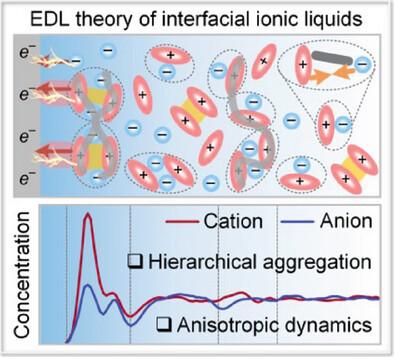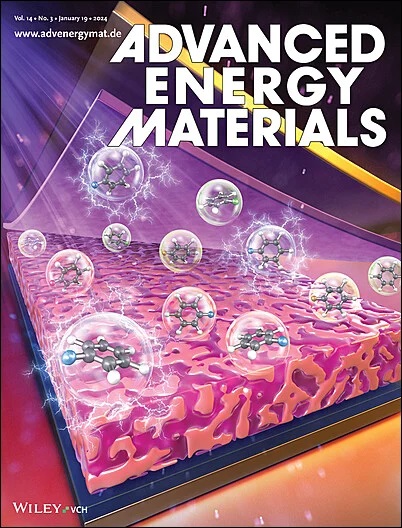捕捉离子分层聚集和各向异性动力学的界面离子液体电双层理论
IF 24.4
1区 材料科学
Q1 CHEMISTRY, PHYSICAL
引用次数: 0
摘要
与水性离子相比,离子液体(IL)完全由阳离子和阴离子组成,由于其独特的性质,可用于能量转换和储存。一个世纪前诞生的经典电双层(EDL)理论为水性界面提供了重要见解,但由于忽略了离子的几何结构和相互作用,该理论在离子液体中失效,从而为描述离子液体界面留下了理论空白。本研究通过结合核磁共振实验、量子化学研究和第一原理分子模拟,捕捉到了 IL 的指纹。基于这些发现,提出了一种 EDL 理论,以反映界面 IL 的分层聚集结构和各向异性动力学。该理论涉及四个要素,包括离子几何、离子-离子相互作用、离子-离子壁相互作用以及温度和界面电场效应。具体来说,具有非均匀形状的多原子离子是连续元素的基石。阳离子-阴离子非氧氢键和阳离子-阳离子 π+-π+ 堆叠产生了结合团簇。离子壁吸附会导致分层聚集模式,而阳离子壁平行堆积则会在界面上产生各向异性动力学。此外,热削弱的离子相互作用和电场增强的界面电子传递改变了界面离子溶胶的聚集状态和动态特性。该理论可适用于不同的电解质壁组合,从而推动下一代电化学能源设备的电解质设计。本文章由计算机程序翻译,如有差异,请以英文原文为准。

Electric Double Layer Theory of Interfacial Ionic Liquids for Capturing Ion Hierarchical Aggregation and Anisotropic Dynamics
Compared to aqueous ions, ionic liquids (ILs) consist entirely of cations and anions, and they function in energy conversion and storage owing to unique properties. Classical electric double layer (EDL) theory born a century ago gives essential insights into aqueous interfaces, whereas it fails in ILs due to overlooking ionic geometries and interactions, leaving a theoretical gap in describing IL interfaces. This study captures IL fingerprints by combining nuclear magnetic resonance experiments, quantum chemistry investigations, and first-principles molecular simulations. Based on these findings, an EDL theory is proposed to reflect hierarchical aggregation structure and anisotropic dynamics for interfacial ILs. It involves four elements including ion geometries, ion–ion interactions, ion–wall interactions, and temperature and interfacial electric field effects. Specifically, polyatomic ions with nonuniform shapes are cornerstones for successive elements. Cation–anion non-oxygen hydrogen bonds and cation–cation π+–π+ stacking generate bound clusters. Ion–wall adsorption causes hierarchical aggregation patterns, and cation–wall parallel stacking creates anisotropic dynamics at interfaces. Moreover, the thermal-weakened ionic interactions and electric field-enhanced interfacial electron transfer alter the aggregation states and dynamic properties of interfacial ILs. This theory is adaptable to various IL–wall combinations, advancing electrolyte design for next-generation electrochemical energy devices.
求助全文
通过发布文献求助,成功后即可免费获取论文全文。
去求助
来源期刊

Advanced Energy Materials
CHEMISTRY, PHYSICAL-ENERGY & FUELS
CiteScore
41.90
自引率
4.00%
发文量
889
审稿时长
1.4 months
期刊介绍:
Established in 2011, Advanced Energy Materials is an international, interdisciplinary, English-language journal that focuses on materials used in energy harvesting, conversion, and storage. It is regarded as a top-quality journal alongside Advanced Materials, Advanced Functional Materials, and Small.
With a 2022 Impact Factor of 27.8, Advanced Energy Materials is considered a prime source for the best energy-related research. The journal covers a wide range of topics in energy-related research, including organic and inorganic photovoltaics, batteries and supercapacitors, fuel cells, hydrogen generation and storage, thermoelectrics, water splitting and photocatalysis, solar fuels and thermosolar power, magnetocalorics, and piezoelectronics.
The readership of Advanced Energy Materials includes materials scientists, chemists, physicists, and engineers in both academia and industry. The journal is indexed in various databases and collections, such as Advanced Technologies & Aerospace Database, FIZ Karlsruhe, INSPEC (IET), Science Citation Index Expanded, Technology Collection, and Web of Science, among others.
 求助内容:
求助内容: 应助结果提醒方式:
应助结果提醒方式:


